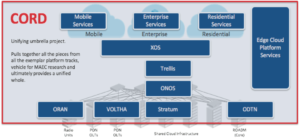CORD snapshot project update from Larry Peterson - ONF CTO and CORD TST Chair:
CORD continues to serve as a overarching centerpiece in ONF’s new strategic plan and across the breadth of ONF’s projects. CORD provides the overall architecture, and component projects ‘plug in’ to provide various component functionality.
The four initial reference designs, announced recently by ONF’s operator leadership, each leverage a subset of component projects and assemble them into a platform for a targeted use case backed by a group of operators. The CORD project provides the ‘big picture’ to help ensure each component, as it evolves, continues to fit organically in with the whole.
Specifically:
- Components of CORD are used by the SEBA project. As SEBA evolves, the work will be folded back into CORD (e.g. NEM)
- NFV Fabric uses the Trellis and ONOS components
- UPAN builds on the NFV Fabric, bringing in Stratum for P4 programmability
- ODTN can be used standalone, and also as the WAN interface from a CORD site
- CORD serves as the platform for trailblazing 5G work on M-CORD.
- CORD is growing to support service chains that span Multi-Cloud Environments.
- And when all this work comes together, CORD is positioned to be the unifying platform for trailblazing work on Multi-Access Edge Cloud.

CORD Updates & Roadmap
The 6th release of the CORD reference implementation (just recently released) is based on Kubernetes and associated client-side tools (e.g., kubectl, helm). This represents a significant shift in how CORD is built and deployed in that it is now possible to:
- Deploy select components without having to deploy CORD as a whole, and
- Deploy a mix of component versions (e.g., released/official and development/experimental).
The CORD 6.0 release includes two service profiles (plus a set of 20+ services):
- R-CORD → The Residential profile includes VOLTHA, ONOS (in support of both Trellis and vOLT), Kafka (a message bus), and XOS. Unlike earlier versions of R-CORD, which allocated a Docker container to every subscriber (known as vSG), the latest release implements the entire subscriber-to-Internet data path in the switches. Of particular note, the full R-CORD configuration includes zero-touch ONU and Subscriber provisioning, which demonstrates a key capability for SEBA.
- M-CORD → The Mobile profile includes a physical eNodeB, a virtual EPC-as-a-Service (in turn constructed from vMME, vSPGW, and vHSS services), OpenStack, ONOS, and XOS. Of particular note, OpenStack is now deployed as a set of Docker containers using Helm.
The release also includes a SimpleExampleService running in a Kubernetes pod, which demonstrates how other Kubernetes micro-services can be integrated in CORD.
There are currently over 30 deployments of CORD, including at Altice Portugal, AT&T, China Unicom, Comcast, DT, Google, NTT, Swisscom, Telecom Italia, Telefonica, and Turk Telekom.
Roadmap for CORD 7.0
The R-CORD profile in version 6.0 will serve as “version 0.1” for SEBA. SEBA will be enhanced in a way that is consistent with the CORD architecture, allowing those enhancements to be folded into the next release of CORD (version 7.0)
CORD will also continue to serve as the platform for M-CORD, with the primary focus being to transition M-CORD from OpenStack to Kubernetes, to bring Kubernetes services into the CORD data plane. Currently, all Kubernetes services run as part of the CORD control plane, but no data plane packets are directly processed by Kubernetes containers.
By supporting both M-CORD and SEBA (R-CORD) running on a common platform, CORD will continue to serve as an exemplar platform for the trailblazing Multi-Access Edge Cloud (MAEC) initiative.

